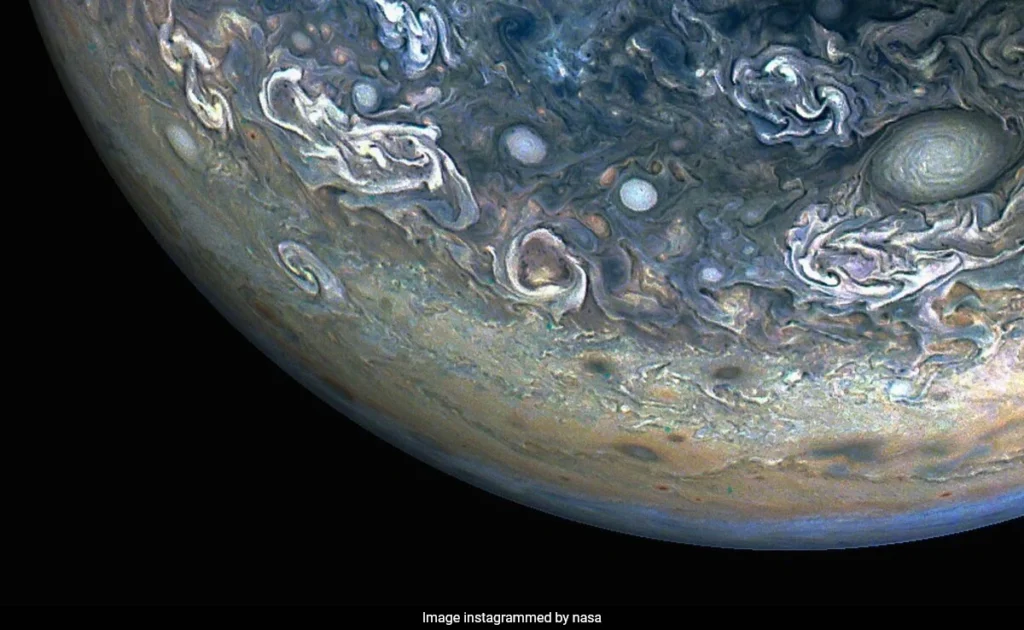NASA's Juno Mission Reveals Stunning View Of Jupiter
The National Aeronautics and Space Administration (NASA) never fails to amaze space lovers as the United States-based organization on Monday released yet another jaw-dropping image of Jupiter, our solar system’s biggest planet. This color-enhanced image shows a mesmerizing Jovian jet stream butted up against itself: the two side-by-side cloud bands at the centre of this composite pretty picture were spotted by NASA’s Juno spacecraft during its 12th perijove close pass to Jupiter on May 23, 2018.

Jupiter's Turbulent Clouds Up Close
Today’s image from NASA is a perfect example, showcasing the turbulent and chaotic world that Jupiter represents. The area imaged here is a “folded filamentary region” where some of the most striking patterns on Jupiter can be found: downwelling dark lanes that are typically associated with Jupiter’s spectacular cloud bands, chaotic and bright updrafts, both long-lived anticyclonic (high-pressure) structures orange features in the image related to warm meteorology. It provides a high-resolution perspective on the circulating storms and whirling clouds in whites, blues and dark orange. Distinctly, two white round shapes at the heart of the image suggest – a face with an open mouth The image is almost whimsical for such a scientific revelation.
Started in 2011, the purpose of this mission is to unpack some secrets related to its origin and especially evolution by observing its atmosphere, maybe magnetic field as well. However, since arriving at Jupiter in 2016 Juno has been scouring the planet for data and snapping some pretty stunning images that have shown us much about how it works. At that point, Juno was 18,000 miles (29,000 kilometers) above the planet’s cloud tops and hurtling past Jupiter at a latitude of about 68 degrees north of its equator. But such high-altitude observations also give scientists an element-by-element look at the dynamic and complex nature of Jupiter’s atmosphere.
Interpreting Jupiter's atmospheric activity
The weather on Jupiter, of course, is among the wildest and most violent in our solar system. More than a dozen prevailing winds circle the planet as well, with some clocking speeds up to 335 miles per hour (539 kilometers per hour) at the equator. One of the most well-known features is the Great Red Spot, a storm that has been monitored for more than 300 years as an enormous swirling oval of clouds twice the size Earth. The new Juno image further fuels this understanding, depicting exactly how and why the zonal jets along with folded filamentary regions impart Jupiter an ever mutable face.
The picture has received over 4 lakh likes on social media, with many going ‘wow’ in the comments section. Comments such as “Awesome!” and The phrase “Juno’s mission keeps uncovering Jupiter’s surprises” and the assertion that space is best artist twirl around in my head, reflecting what feels like a shared sense of wonder with NASA as it continues to explore our most-outer reaches.
For the most recent headlines on space science, and scientific discoveries stay tuned with Samayajyothi.
Share this post :
KTR Accuses Revanth Reddy’s Brother-in-Law of Securing Lucrative Government Contracts with Minimal Business Background
NASA says: Two Big Space Rocks To Dangerously Flyby Earth Today
Wayanad Landslides- Army Rescues Thousands From Cloudburst, Managed To Save More Than 190 Others
Horror on Tracks in Jharkhand: Howrah-Mumbai Mail Runs Into Derailed Train; 2 Dead, 20 Injured
Subscribe our newsletter
Purus ut praesent facilisi dictumst sollicitudin cubilia ridiculus.